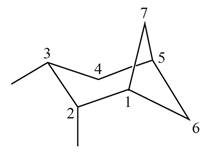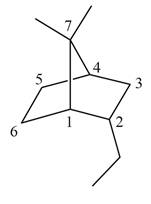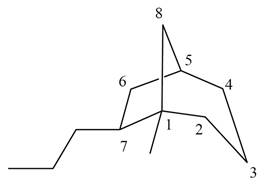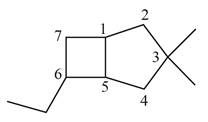
Concept explainers
Read Appendix B on naming bicyclic compounds. Then give IUPAC name for each of the following compounds.
a. 
b. 
c. 
d. 
(a)
Interpretation: The IUPAC name for the given bicyclic compound is to be stated.
Concept introduction: The root name of bicyclic compounds depends upon the number of carbon atoms present in the rings. The naming of bicyclic compounds is done as,
(1) The total number of carbon atoms in the molecule is to be counted. It represents the root name.
(2) The number of carbon atoms between the bridgeheads is to be counted and placed in square brackets in descending order.
(3) The word bicyclo is placed at the beginning of the name.
The general name such compounds is represented as
Answer to Problem 4.75P
The IUPAC name for the given bicyclic compound is
Explanation of Solution
The given bicyclic compound is shown below.

Figure 1
The given compound contains seven carbon atoms in the ring which are single bonded to each other. Therefore, the root name is heptane. In this case, there are
The IUPAC name for the given bicyclic compound is
(b)
Interpretation: The IUPAC name for the given bicyclic compound is to be stated.
Concept introduction: The root name of bicyclic compounds depends upon the number of carbon atoms present in the rings. The naming of bicyclic compounds is done as,
(1) The total number of carbon atoms in the molecule is to be counted. It represents the root name.
(2) The number of carbon atoms between the bridgeheads is to be counted and placed in square brackets in descending order.
(3) The word bicyclo is placed at the beginning of the name.
The general name such compounds is represented as
Answer to Problem 4.75P
The IUPAC name for the given bicyclic compound is
Explanation of Solution
The given bicyclic compound is shown below.

Figure 2
The given compound contains seven carbon atoms in the ring which are single bonded to each other. Therefore, the root name is heptane. In this case, there are
The IUPAC name for the given bicyclic compound is
(c)
Interpretation: The IUPAC name for the given bicyclic compound is to be stated.
Concept introduction: The root name of bicyclic compounds depends upon the number of carbon atoms present in the rings. The naming of bicyclic compounds is done as,
(1) The total number of carbon atoms in the molecule is to be counted. It represents the root name.
(2) The number of carbon atoms between the bridgeheads is to be counted and placed in square brackets in descending order.
(3) The word bicyclo is placed at the beginning of the name.
The general name such compounds is represented as
Answer to Problem 4.75P
The IUPAC name for the given bicyclic compound is
Explanation of Solution
The given bicyclic compound is shown below.

Figure 3
The given compound contains eight carbon atoms in the ring which are single bonded to each other. Therefore, the root name is octane. In this case, there are
The IUPAC name for the given bicyclic compound is
(d)
Interpretation: The IUPAC name for the given bicyclic compound is to be stated.
Concept introduction: The root name of bicyclic compounds depends upon the number of carbon atoms present in the rings. The naming of bicyclic compounds is done as,
(1) The total number of carbon atoms in the molecule is to be counted. It represents the root name.
(2) The number of carbon atoms between the bridgeheads is to be counted and placed in square brackets in descending order.
(3) The word bicyclo is placed at the beginning of the name.
The general name such compounds is represented as
Answer to Problem 4.75P
The IUPAC name for the given bicyclic compound is
Explanation of Solution
The given bicyclic compound is shown below.

Figure 4
The given compound contains seven carbon atoms in the ring which are single bonded to each other. Therefore, the root name is heptane. In this case, there are
The IUPAC name for the given bicyclic compound is
Want to see more full solutions like this?
Chapter 4 Solutions
PKG ORGANIC CHEMISTRY
Additional Science Textbook Solutions
Organic Chemistry (8th Edition)
Physics of Everyday Phenomena
Campbell Biology: Concepts & Connections (9th Edition)
General, Organic, and Biological Chemistry - 4th edition
Laboratory Manual For Human Anatomy & Physiology
Biology: Concepts and Investigations
- Part C IN H N. Br₂ (2 equiv.) AlBr3 Draw the molecule on the canvas by choosing buttons from the Tools (for bonds and + e (×) H± 12D T EXP. L CONT. דarrow_forward9. OA. Rank the expected boiling points of the compounds shown below from highest to lowest. Place your answer appropriately in the box. Only the answer in the box will be graded. (3) points) OH OH بر بد بدید 2 3arrow_forwardThere is an instrument in Johnson 334 that measures total-reflectance x-ray fluorescence (TXRF) to do elemental analysis (i.e., determine what elements are present in a sample). A researcher is preparing a to measure calcium content in a series of well water samples by TXRF with an internal standard of vanadium (atomic symbol: V). She has prepared a series of standard solutions to ensure a linear instrument response over the expected Ca concentration range of 40-80 ppm. The concentrations of Ca and V (ppm) and the instrument response (peak area, arbitrary units) are shown below. Also included is a sample spectrum. Equation 1 describes the response factor, K, relating the analyte signal (SA) and the standard signal (SIS) to their respective concentrations (CA and CIS). Ca, ppm V, ppm SCa, arb. units SV, arb. units 20.0 10.0 14375.11 14261.02 40.0 10.0 36182.15 17997.10 60.0 10.0 39275.74 12988.01 80.0 10.0 57530.75 14268.54 100.0…arrow_forward
- A mixture of 0.568 M H₂O, 0.438 M Cl₂O, and 0.710 M HClO are enclosed in a vessel at 25 °C. H₂O(g) + C₁₂O(g) = 2 HOCl(g) K = 0.0900 at 25°C с Calculate the equilibrium concentrations of each gas at 25 °C. [H₂O]= [C₁₂O]= [HOCI]= M Σ Marrow_forwardWhat units (if any) does the response factor (K) have? Does the response factor (K) depend upon how the concentration is expressed (e.g. molarity, ppm, ppb, etc.)?arrow_forwardProvide the structure, circle or draw, of the monomeric unit found in the biological polymeric materials given below. HO OH amylose OH OH 행 3 HO cellulose OH OH OH Ho HOarrow_forward
- OA. For the structure shown, rank the bond lengths (labeled a, b and c) from shortest to longest. Place your answer in the box. Only the answer in the box will be graded. (2 points) H -CH3 THe b Нarrow_forwardDon't used hand raitingarrow_forwardQuizzes - Gen Organic & Biological Che... ☆ myd21.lcc.edu + O G screenshot on mac - Google Search savings hulu youtube google disney+ HBO zlib Homework Hel...s | bartleby cell bio book Yuzu Reader: Chemistry G periodic table - Google Search b Home | bartleby 0:33:26 remaining CHEM 120 Chapter 5_Quiz 3 Page 1: 1 > 2 > 3 > 6 ¦ 5 > 4 > 7 ¦ 1 1 10 8 ¦ 9 a ¦ -- Quiz Information silicon-27 A doctor gives a patient 0.01 mC i of beta radiation. How many beta particles would the patient receive in I minute? (1 Ci = 3.7 x 10 10 d/s) Question 5 (1 point) Saved Listen 2.22 x 107 222 x 108 3.7 x 108 2.22 x 108 none of the above Question 6 (1 point) Listen The recommended dosage of 1-131 for a test is 4.2 μCi per kg of body mass. How many millicuries should be given to a 55 kg patient? (1 mCi = 1000 μСi)? 230 mCiarrow_forward
 Chemistry for Today: General, Organic, and Bioche...ChemistryISBN:9781305960060Author:Spencer L. Seager, Michael R. Slabaugh, Maren S. HansenPublisher:Cengage Learning
Chemistry for Today: General, Organic, and Bioche...ChemistryISBN:9781305960060Author:Spencer L. Seager, Michael R. Slabaugh, Maren S. HansenPublisher:Cengage Learning Organic Chemistry: A Guided InquiryChemistryISBN:9780618974122Author:Andrei StraumanisPublisher:Cengage Learning
Organic Chemistry: A Guided InquiryChemistryISBN:9780618974122Author:Andrei StraumanisPublisher:Cengage Learning Introductory Chemistry: An Active Learning Approa...ChemistryISBN:9781305079250Author:Mark S. Cracolice, Ed PetersPublisher:Cengage Learning
Introductory Chemistry: An Active Learning Approa...ChemistryISBN:9781305079250Author:Mark S. Cracolice, Ed PetersPublisher:Cengage Learning World of Chemistry, 3rd editionChemistryISBN:9781133109655Author:Steven S. Zumdahl, Susan L. Zumdahl, Donald J. DeCostePublisher:Brooks / Cole / Cengage Learning
World of Chemistry, 3rd editionChemistryISBN:9781133109655Author:Steven S. Zumdahl, Susan L. Zumdahl, Donald J. DeCostePublisher:Brooks / Cole / Cengage Learning




